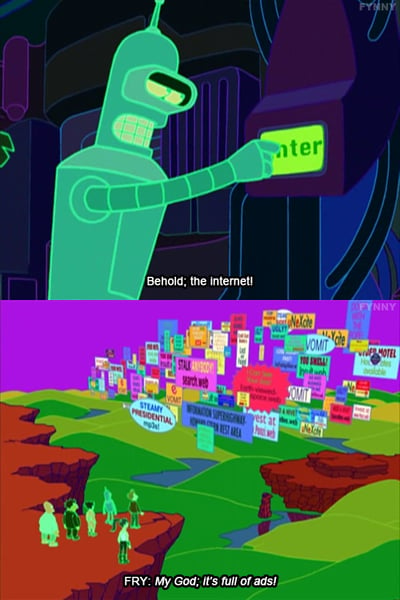Picture this… You visit a company’s website. You’re interested in what they sell, or you’re checking out some of their resources. If you’re already on the website, there’s a high probability you’re a warm lead.
Then the chatbot pops up. And the privacy consent. And a banner promoting a new ebook. And a newsletter signup form.
You click out of them, or try to ignore them. The chatbot gets more insistent. Something on the page starts to wiggle to attract your attention. Register now! Learn more! Get a demo!

At this point, you’re so annoyed, you either close the page or submit your contact information out of desperation.
And this is why your customer experience sucks
What I just described is a crappy customer experience. But sadly, it's not uncommon. In fact, it’s what we’ve come to expect from every B2B SaaS company’s website. Because we all do it. I’ve done it. We market to them until they tell us to stop.
Everything’s data-driven now, so we can test everything. And boy do we. What if the chatbot pops up after 10 seconds instead of 5? What if the chatbot looks like a cute cartoon robot? What if the CTA button has an exclamation point? What if we write our copy so it sounds like we’re already BFFs?
We started with surprise and delight and we’ve somehow ended up with irritate and disappoint.
And I get it. We like subscription businesses because they’re infinitely adjustable. We can make small adjustments anywhere in the customer lifecycle and they can impact acquisition and retention in huge ways. We can add more and more traps CTAs to make sure we eventually ensnare convert that prospect.
Or at least, we tell ourselves that. But what are all these adjustments and CTAs actually doing?
We’re annoying everyone who interacts with us.
It's not really about the chatbots
I know I’m picking on chatbots a lot. The thing is, I don’t hate chatbots. When they’re implemented thoughtfully and aligned with overall sales goals, chatbots can work really well. It’s great to have someone (something?) respond quickly when prospects or customers are ready with a question.
But they’re emblematic of a larger issue festering in B2B SaaS businesses. I could have used a dozen other examples, like nurture emails after a demo request, or sales outreach tactics, or in-product upsell messages. The list goes on. And at every step of the customer lifecycle, we’re doing this. We're badgers, chipping away at a customer until they finally relent. It’s not just marketing’s fault. You can’t pin this on sales. Don’t blame the account management team.
All of us are responsible for customer experience. That includes marketing, new business, retention and expansion, support, product.
Part of the problem lies in alignment in the revenue org. Despite all the thought leadership written about how SaaS businesses can achieve sales and marketing alignment, is that really true in your organization? We have disparate objectives and occasionally conflicting methods to achieve them, and our customers often bear the brunt of our disfunction. We end up with a hundred different CTAs on our website because someone needs visitors to download an ebook, while someone else needs them to sign up for a webinar, or follow us on Twitter, or read about a new product update, or request a demo.
We all have to work better together, because we’re all working toward the same goal: more and happier customers.
What happened to the customer experience anyway?
When was the last time you visited your website as a customer would? Read some pages, request a demo, sign up for a newsletter. No matter how closely connected you’ve been to setting up this process, no matter where you sit in the GTM team, I bet you’ll be surprised at how disjointed and annoying the full process has become.
We’ve gotten into this mindset where there’s no room for subtlety in the customer experience. Over time, we've added more and more (and larger and larger) CTAs to our CX - starting with the website, but including outreach tactics, nurtures, the product, etc... Let’s make sure a prospect can’t miss how to request a demo. Let's add another button in case they didn't see the first one. Let’s remind them how to get in touch with us. Let’s ask them over and over and over to do more with us.
We’ve decided no one reads anything, so instead we beat people over the head with tons of short, snappy, supersized messages that don’t mean anything.
“Ready to experience [Brand X]?”
No, no one wants to "experience" your brand.
Why is this a problem?
- It’s annoying. Do not annoy a potential customer. That should be rule 1.
- It’s interruptive. It gets in the way of the reason someone is interacting with you in the first place.
- It’s ineffective. Eventually if we give someone enough things to click on, they're going to click on something. It doesn't mean they're actually interested, just that they're tired.
So, what’s the solution?
We need to go back to basics. Take a step back from your day-to-day growth hacking, and really look at what your customer goes through. The customer experience, from start to finish, should be:
- Consistent
- Simple
- Easy
- Invisible
That means from the moment they encounter your brand, they’re never annoyed. They’re delighted. And that doesn’t stop when they move from marketing to sales and from sales to customer success, and at every step in between, before and after.
Try following the first rules you ever learned about effective communication.
- Be direct
- Be specific
- Use real words
- Don’t overhype
- Don't overcomplicate it
- Stop bugging people so much
We all want to personalize our customer’s experience. We want to optimize every step of that journey. These are the right goals, and we shouldn’t lose sight of them. But it’s time we took a closer look at how we’re achieving them.
Like this post? We've got lots more like it, along with videos, expert Q&As and more in our newsletter. Sign up here!




